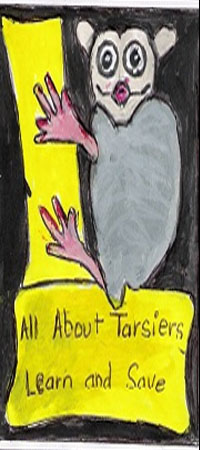|
All species of tarsier share the same general features: large eyes, large bat-like ears, soft fur, long hind legs and a long hairless tail. They also have long thin fingers, with the third finger the longest. Tarsiers have nails on most of their fingers, with claws on the 2nd and 3rd toes of the hind feet for grooming. Tarsiers have very large eyes to enable them to see well in the dark and their eyeballs are around as large as their brains, although size varies between species. Tarsiers have soft, sleek fur, the color of which varies between species but is mainly brown, beige or grey to help camouflage them among the branches and undergrowth. The tarsier brain differs from that of other primates - there is a unique connection between the brain and the eyes and this separates tarsiers from lemurs, lorises and monkeys, which all have similar brains. Tarsiers are very good at picking up signs of prey or predators – their large ears are very sensitive and can hear the smallest sounds and they can turn their heads almost 360° to cover the whole area around them. Tarsiers also have sticky pads on each of their fingers which help with climbing, leaping and catching prey.
The three tarsier groups can be distinguished by their features: the western group have the largest eyes, the eastern group the smallest and the Philippine group are in the middle; the western tarsiers have the smallest ears, the eastern tarsiers the largest and again the Philippine group are in between; the western group have the longest hind limbs and hands, the eastern group have the shortest and the Philippine tarsiers are intermediate. The tufts on the end of tarsier’s tails also vary between species groups – the eastern tarsiers have a large furry tuft, the Philippine group a very sparse, short tuft and the western tarsiers somewhere between the two. These features can be used to aid identification of individuals. Tail length varies between species and is only distinctive in the pygmy tarsier which is much smaller than the other species and thus has a shorter tail.
The subspecies of tarsier are difficult to tell apart from each other and some vary in terms of distribution and vocalizations rather than the way they look. The tarsier species show rather more variation and can usually be identified by looks along with the area found. T. tarsier has a rather furry tail which covers more than half of the length and is a light grey color, T. fuscus is a darker grey than the spectral tarsier and has a much smaller and shorter tail tuft, T. pumilus is very small with a very furry tail, T. sangirensis is a brown color with an almost hairless tail, T. pelengensis is a mix of brown and grey with an especially long tail, T. dentatus is rather small with dark grey fur and a very dark colored tail, T. tumpara has mixed brown and grey fur with a dark brown ‘v’ shape above its nose, T. lariang has black eye rims and a thick black tail tuft and T. wallacei has fairly large ears, yellow-brown fur and a coppery throat.
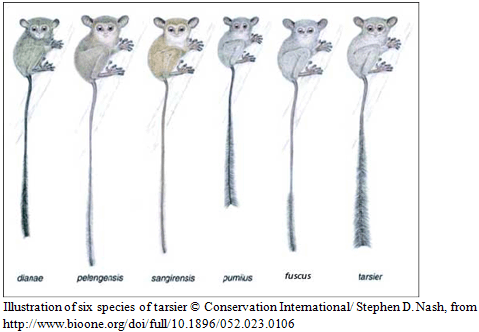
Behavior/Social Structure/Relationships
Originally it was thought that tarsiers were solitary animals, but research now suggests that this is not the case, although the amount of interaction varies between species. Spectral tarsiers and the Lariang tarsier are mainly monogamous (one female and one male forming a mating pair together) and the pair will keep their own territories with some overlap. Other tarsiers do not seem to have monogamous relationships, in particular C. bancanus and C. syrichta where males mate with many females with territories overlapping their own. The western tarsiers are thought to be the least socially active, with the Philippine tarsiers showing intermediate social behavior and the Eastern tarsiers the most social. In spectral tarsiers it has been found that social interactions vary with food availability and this species will forage alone when insect abundance is low. Dian’s tarsiers will increase the distance between themselves and others in the group when food resources are limited and will decrease the distance when food is abundant. Spectral tarsiers show the most social behavior at their sleeping sites, including playing, grooming and snuggling.
Group size and composition varies between species. In spectral tarsiers the average group size is three, which usually consists of a mated pair, sometimes an additional female and offspring but never another male. Dian’s tarsier groups are also usually made of one male, one or two females and offspring sharing a sleeping site. C. bancanus and C. syrichta do not sleep in groups and are often found alone. Spectral tarsier offspring disperse from their group when they reach adulthood and establish their own sleeping sites and groups.
As tarsiers have their own ranges they show territorial behavior like patrolling and defense of their area, as well as scent marking and vocalizations to advertise their territory. In spectral tarsiers the group will defend the territory and may lunge at or chase the intruders. The duet vocalizations described below may also act as territory defense, especially when made at a groups sleeping site. Dian’s tarsier is known to establish sleeping sites near to the boundary of their territory, to keep an eye on the periphery. Tarsiers are very wary of predators, including feral cats, owls, small carnivores, large snakes and large birds of prey and are vigilant of attack. They are also very shy and do not benefit from contact with humans.
Continue on page 4
|
|
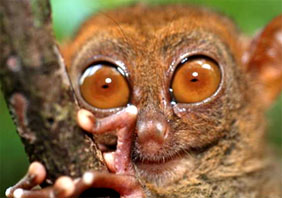
Tarsiers have large eyes, large bat-like ears, and soft fur. © Pierre Fidenci
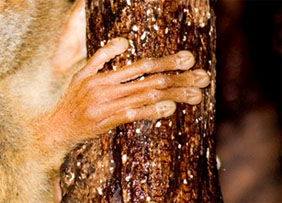
Finger pads of the spectral tarsier. © Paddy Ryan
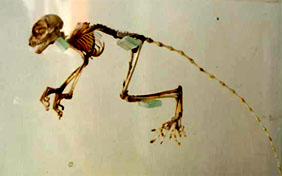
Philippine Tarsier skeleton. © Jeroen Hellingman
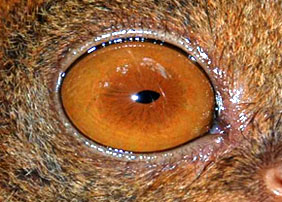
Tarsier's eye. © Pierre Fidenci
|

